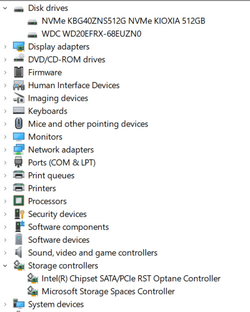Hi. I would be grateful for advice on how to change the SATA configuration from Raid to AHCI in BIOS.
My son has an i5 12th Generation All In One desktop and is configured in Raid mode in the BIOS. It has only 1 SSD Drive.
When changing from Raid to AHCI, many online articles say to boot in to Safe Mode first (either using Command Prompt or msconfig) then change from Raid to AHCI in the BIOS. He called tech support and was told that it was not necessary to boot to safe mode before changing.
He wants to do a clean install of Windows 11 Home, which he is familiar with, however to view the drive to install windows requires the Intel Rapid Storage Driver to be installed first - a procedure he is unsure of. (Due to distance, he will be doing this himself). Tech support told him that by changing from Raid to AHCI the drive would be visible without having the extra step of installing the IRST Driver on the Media Creation Tool.
Would he be able to change from Raid to AHCI without doing a clean install of Windows 11 Home immediately after, and would that require booting to Safe Mode first?
Also, is there any difference in booting to Safe Mode using the Command Prompt (bcdedit......safeboot minimal) and using msconfig/boot/safeboot minimal which may be easier for him?
Apologies if these are fairly basic questions and thanks in advance for your help.
Mitch.
My son has an i5 12th Generation All In One desktop and is configured in Raid mode in the BIOS. It has only 1 SSD Drive.
When changing from Raid to AHCI, many online articles say to boot in to Safe Mode first (either using Command Prompt or msconfig) then change from Raid to AHCI in the BIOS. He called tech support and was told that it was not necessary to boot to safe mode before changing.
He wants to do a clean install of Windows 11 Home, which he is familiar with, however to view the drive to install windows requires the Intel Rapid Storage Driver to be installed first - a procedure he is unsure of. (Due to distance, he will be doing this himself). Tech support told him that by changing from Raid to AHCI the drive would be visible without having the extra step of installing the IRST Driver on the Media Creation Tool.
Would he be able to change from Raid to AHCI without doing a clean install of Windows 11 Home immediately after, and would that require booting to Safe Mode first?
Also, is there any difference in booting to Safe Mode using the Command Prompt (bcdedit......safeboot minimal) and using msconfig/boot/safeboot minimal which may be easier for him?
Apologies if these are fairly basic questions and thanks in advance for your help.
Mitch.
My Computer
System One
-
- OS
- Windows 11 Home








